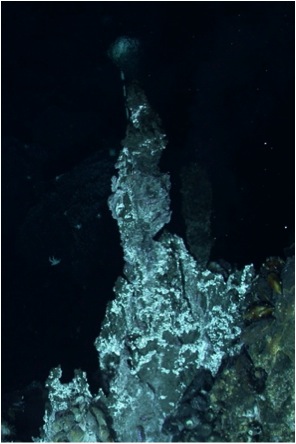
After leaving Kilo Moana, we headed south to the ABE vent field. The ABE vent field is in a transition zone of the ELSC. One question scientists on board are interested in answering is whether this is reflected by the composition of the microbial communities. ABE is approx. ~180 meters shallower than at Kilo Moana, and has a more felsic substrate and slightly less acidic vent fluid (pH 4.3-4.9). The Jason team was very successful in obtaining samples and scientists had a very busy night processing those brought on board. Pictured below is sample of a sulfide chimney top being placed in one of the sample cylinders that sits on the front of Jason.
The igneous rock, andesite (pictured below), is more felsic and silicious than basalt, and forms as the subducting oceanic crust (rich in minerals) mixes with magma. We see an increase in the abundance of felsic vs basaltic substrate material as we get closer to the subducting zone.





